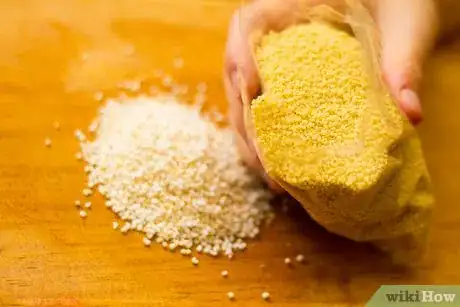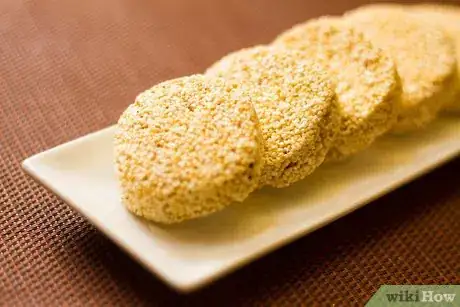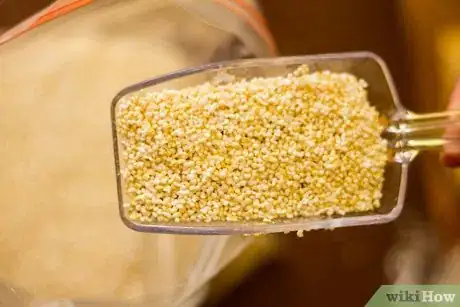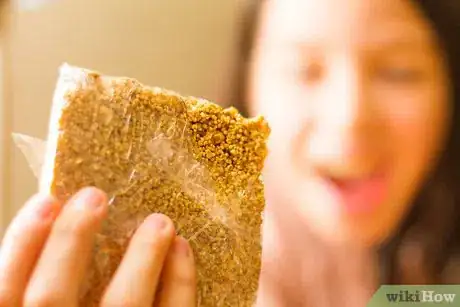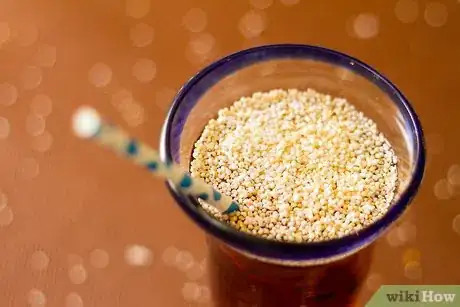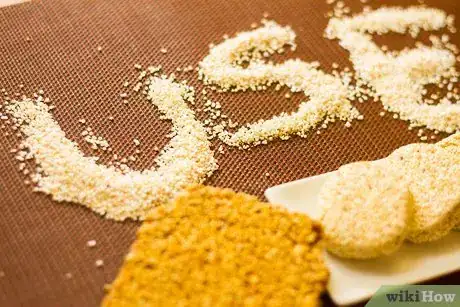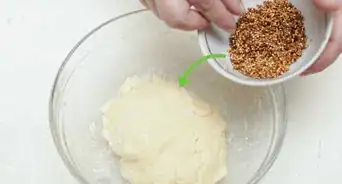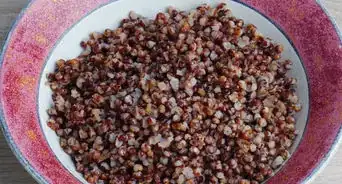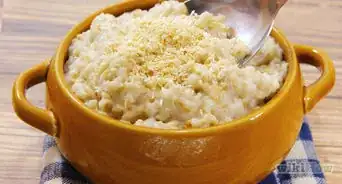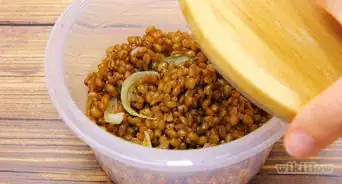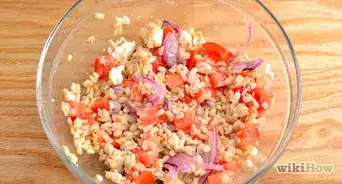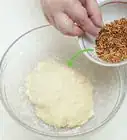wikiHow is a “wiki,” similar to Wikipedia, which means that many of our articles are co-written by multiple authors. To create this article, volunteer authors worked to edit and improve it over time.
wikiHow marks an article as reader-approved once it receives enough positive feedback. In this case, 94% of readers who voted found the article helpful, earning it our reader-approved status.
This article has been viewed 171,020 times.
Learn more...
Considered an ancient grain, amaranth is a great source of nutrition. It has high fiber at 15%, high protein at 14% and can be used in many ways. It also contains high lysine, an amino acid found in few foods and higher calcium than most other grains. The best reason to eat amaranth is for its high nutritional value, but it also can become a staple food in the diets of people who are diabetic or have celiac because of its low glycemic index value and lack of gluten. Children also benefit from amaranth in their diet because of its high nutritional value. Amaranth is a whole grain and can also be counted as a vegetable. Although amaranth is gaining popularity, it is still not widely used and many people are unsure how to cook and eat amaranth. Knowing how to use amaranth will help you incorporate it into your diet more often.
Steps
Using Amaranth as the Grain Portion of a Meal
The Institute of Medicine recommends consuming grains as part of a healthy meal. These grains can be served separately or as a part of a dish. Amaranth is a nice substitute for rice or pasta in a meal and satisfies the grain portion of the meal.
-
1Serve amaranth instead of rice.
- Use 2.5 to 3 cups of water to 1 cup of amaranth.
- Simmer it in a covered pan for approximately 20 minutes.
- All the water should absorb and the grains should be fluffy when finished.
- You can also toast the amaranth in butter and add some of it into a rice pilaf with rice and other grains.
-
2Use amaranth instead of couscous, risotto or orzo in pasta dishes. Amaranth works well because the texture and size are not far off from these pastas or grains. You will want to use slightly less water to cook the amaranth to help it retain its structure.
- Make whole grain rolls with amaranth. Amaranth is a nice addition to whole grain breads. It can either be used whole or as flour.
- Using it whole, it will add texture and nuttiness to the bread.
- If using the flour, you can substitute 5% to 30% of the regular flour with amaranth flour, and the only other change you need to make to the recipe would be a slight increase in water.
- It also works well as gluten free flour. When making gluten free rolls, you will need to substitute all the regular flour for amaranth flour, increase the water and add xanthan gum and a starch to help the bread bake correctly.
Advertisement - Make whole grain rolls with amaranth. Amaranth is a nice addition to whole grain breads. It can either be used whole or as flour.
-
3Make amaranth instead of oatmeal.
- Amaranth can be simmered in juice for a sweet flavor.
- Add nuts, spices and fruit for a healthy and sweet breakfast.
-
4Add amaranth to soups or chili. Amaranth flour can be added to thicken up soups or cooked amaranth can be added for flavor and texture.
Preparing Amaranth in Dessert
Amaranth has a mild flavor that lends itself well to many applications, including dessert. Many people describe amaranth as being slightly nutty and toasty.
-
1Make amaranth pudding. This is just like rice pudding. You can follow a rice pudding recipe and just substitute the amaranth for rice.
-
2Use amaranth to make cookies.
- Amaranth seeds add a nice crunch to cookies.
- The flour can also be used to make gluten free cookies. You only need to substitute the amaranth flour for regular flour when making a gluten free cookie. This will affect the flavor and give a slightly dryer cookie. To help counter these effects, try adding applesauce to your cookie recipe. The applesauce will add some flavor and retain moisture.
Baking with Amaranth
Amaranth works well in baked applications, especially for gluten free baked goods. Using amaranth in baked goods increases the nutritional value, mainly the fiber and protein. Also, amaranth has a low glycemic index and people looking to keep blood sugar stable while still enjoying baked goods can do that with amaranth.
-
1Substitute a portion of regular flour or whole wheat flour with amaranth flour. By substituting no more than 30% of the flour with amaranth you can still follow most recipes, with the exception being the amount of water. You may need more water when using amaranth flour because it absorbs more liquid than regular flour.
-
2Make gluten free baked goods. Going gluten free in baking requires more changes to recipes because you need a way to build air structure in bread without gluten. The way this is overcome is by using xanthan gum and a starch. When making cookies or baked goods that don’t require much air cell structure, you may be able to substitute 100% of the flour.
-
3Add whole amaranth for flavor and texture. You can toast the seeds before you use it or just add them raw to many bread and cookie recipes. Toasted amaranth seeds go well in items like biscotti because they add flavor and crunch.
Making Amaranth Part of a Healthy Snack
Healthy snacking is part of a balanced diet. Ideally, when snacking you want carbohydrates and protein to help satiate you until the next meal. Amaranth provides carbohydrates and protein and can be added to many snack foods.
-
1Pop amaranth into a crunchy snack. Amaranth will pop easily and creates nice “puffs” that can be eaten alone or added to a snack mix.
- To pop the amaranth, add 1 to 2 tablespoons of amaranth to a very hot skillet.
- Stir the seeds continuously until they pop and while they are popping.
- Once most of the seeds have popped, quickly remove them from the pan to avoid burning them.
- Try drizzling honey and cinnamon on popped amaranth for a sweet snack.
-
2Add course ground amaranth to smoothies. This will boost the nutritional value of the smoothie while giving it a thicker texture and nutty flavor.
-
3Finished.
Community Q&A
Did you know you can get answers researched by wikiHow Staff?
Unlock staff-researched answers by supporting wikiHow
-
QuestionIs amaranth healthy?
 wikiHow Staff EditorThis answer was written by one of our trained team of researchers who validated it for accuracy and comprehensiveness.
wikiHow Staff EditorThis answer was written by one of our trained team of researchers who validated it for accuracy and comprehensiveness.
Staff Answer wikiHow Staff EditorStaff Answer
wikiHow Staff EditorStaff Answer -
QuestionCan you eat amaranth leaves?
 wikiHow Staff EditorThis answer was written by one of our trained team of researchers who validated it for accuracy and comprehensiveness.
wikiHow Staff EditorThis answer was written by one of our trained team of researchers who validated it for accuracy and comprehensiveness.
Staff Answer wikiHow Staff EditorStaff AnswerYes, the leaves of amaranth are edible, the Aztecs used to boil the leaves and eat them as a vegetable. If you want to enjoy amaranth as a vegetable, use either any leaves from a young amaranth plant (or even the whole plant if you can spare it) or just go for the fresh growing tips of larger, older plants. If the leaves have spines, these need to be scraped off before boiling.
wikiHow Staff EditorStaff AnswerYes, the leaves of amaranth are edible, the Aztecs used to boil the leaves and eat them as a vegetable. If you want to enjoy amaranth as a vegetable, use either any leaves from a young amaranth plant (or even the whole plant if you can spare it) or just go for the fresh growing tips of larger, older plants. If the leaves have spines, these need to be scraped off before boiling. -
QuestionWhat is a pseudocereal?
 wikiHow Staff EditorThis answer was written by one of our trained team of researchers who validated it for accuracy and comprehensiveness.
wikiHow Staff EditorThis answer was written by one of our trained team of researchers who validated it for accuracy and comprehensiveness.
Staff Answer wikiHow Staff EditorStaff AnswerA pseudocereal refers to a plant that has starch-filled seeds or fruits that we treat as a grain. The reason such seeds or fruits are called "pseudocereal" is that they do not meet the botanical requirements to be considered a true cereal grain but they get used in much the same way for our diet (e.g., as a cereal, as flour, etc.). Many pseudocereals were staples in ancient cultures, like amaranth, quinoa and buckwheat. In general, they have highly nutritious profiles, which is why many of them are getting "rediscovered" in current times and are thought by agricultural experts to be an underappreciated source of future nutrition (Rosentrater and Evers 2018). Another name you might find these seeds and fruits referred to is "pseudograin".
wikiHow Staff EditorStaff AnswerA pseudocereal refers to a plant that has starch-filled seeds or fruits that we treat as a grain. The reason such seeds or fruits are called "pseudocereal" is that they do not meet the botanical requirements to be considered a true cereal grain but they get used in much the same way for our diet (e.g., as a cereal, as flour, etc.). Many pseudocereals were staples in ancient cultures, like amaranth, quinoa and buckwheat. In general, they have highly nutritious profiles, which is why many of them are getting "rediscovered" in current times and are thought by agricultural experts to be an underappreciated source of future nutrition (Rosentrater and Evers 2018). Another name you might find these seeds and fruits referred to is "pseudograin".

